What Is A Major Factor In The Development Of Health Problems In Transporting Animals?
Transport (in British English language), or transportation (in American English), is the movement of humans, animals, and appurtenances from ane location to another. In other words, the action of transport is defined equally a particular motion of an organism or affair from a bespeak A (a place in infinite) to a point B.
Modes of transport include air, land (runway and road), water, cable, pipeline, and space. The field tin can exist divided into infrastructure, vehicles, and operations. Transport enables merchandise between people, which is essential for the development of civilizations.
Send infrastructure consists of the stock-still installations, including roads, railways, airways, waterways, canals, and pipelines and terminals such equally airports, railway stations, bus stations, warehouses, trucking terminals, refueling depots (including fueling docks and fuel stations), and seaports. Terminals may exist used both for interchange of passengers and cargo and for maintenance.
Means of send are whatever of the unlike kinds of send facilities used to carry people or cargo. They may include vehicles, riding animals, and pack animals. Vehicles may include wagons, automobiles, bicycles, buses, trains, trucks, helicopters, watercraft, spacecraft, and aircraft.
Modes [edit]

A mode of transport is a solution that makes apply of a particular blazon of vehicle, infrastructure, and operation. The send of a person or of cargo may involve 1 style or several of the modes, with the latter case being called inter-modal or multi-modal transport. Each mode has its ain advantages and disadvantages, and will exist called on the basis of cost, capability, and road.
Governments bargain with the way the vehicles are operated, and the procedures set for this purpose, including financing, legalities, and policies. In the transport industry, operations and ownership of infrastructure tin be either public or private, depending on the state and mode.
Passenger transport may exist public, where operators provide scheduled services, or private. Freight transport has become focused on containerization, although bulk ship is used for large volumes of durable items. Transport plays an important role in economic growth and globalization, but most types crusade air pollution and employ large amounts of state. While it is heavily subsidized by governments, good planning of transport is essential to brand traffic period and restrain urban sprawl.
Human-powered [edit]

Human-powered transport, a grade of sustainable send, is the send of people and/or goods using human musculus-ability, in the form of walking, running, and pond. Modernistic technology has allowed machines to enhance homo power. Human-powered send remains popular for reasons of cost-saving, leisure, physical practise, and environmentalism; it is sometimes the only type available, especially in underdeveloped or inaccessible regions.
Although humans are able to walk without infrastructure, the transport can exist enhanced through the use of roads, especially when using the human power with vehicles, such as bicycles and inline skates. Homo-powered vehicles take too been developed for difficult environments, such as snow and h2o, by watercraft rowing and skiing; even the air tin be entered with human-powered shipping.
Animal-powered [edit]
Brute-powered transport is the utilize of working animals for the movement of people and commodities. Humans may ride some of the animals direct, use them as pack animals for carrying appurtenances, or harness them, alone or in teams, to pull sleds or wheeled vehicles.
Air [edit]
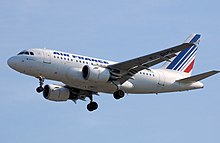
A stock-still-fly aircraft, commonly called an airplane, is a heavier-than-air arts and crafts where movement of the air in relation to the wings is used to generate lift. The term is used to distinguish this from rotary-wing aircraft, where the movement of the lift surfaces relative to the air generates lift. A gyroplane is both fixed-fly and rotary wing. Fixed-wing aircraft range from small trainers and recreational aircraft to large airliners and military cargo shipping.
Two things necessary for aircraft are air flow over the wings for elevator and an area for landing. The majority of aircraft also need an drome with the infrastructure for maintenance, restocking, and refueling and for the loading and unloading of crew, cargo, and passengers.[1] While the vast majority of aircraft land and take off on country, some are capable of take-off and landing on water ice, snow, and calm water.
The aircraft is the second fastest method of transport, after the rocket. Commercial jets can accomplish up to 955 kilometres per hr (593 mph), unmarried-engine aircraft 555 kilometres per hour (345 mph). Aviation is able to chop-chop transport people and limited amounts of cargo over longer distances, only incurs high costs and energy use; for short distances or in inaccessible places, helicopters can exist used.[2] As of April 28, 2009, The Guardian commodity notes that "the WHO estimates that up to 500,000 people are on planes at any time."[three]
Land [edit]
State transport covers all state-based transport systems that provide for the movement of people, goods, and services. Land transport plays a vital role in linking communities to each other. Land transport is a key cistron in urban planning. Information technology consists of two kinds, track and road.
Rail [edit]
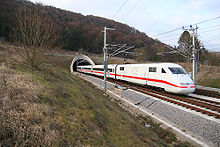

The Beijing Subway is one of the world's largest and busiest rapid transit networks.
Track ship is where a train runs along a set of two parallel steel rails, known as a railway or railroad. The rails are anchored perpendicular to ties (or sleepers) of timber, concrete, or steel, to maintain a consistent distance autonomously, or gauge. The rails and perpendicular beams are placed on a foundation made of concrete or compressed world and gravel in a bed of ballast. Alternative methods include monorail and maglev.
A train consists of 1 or more than connected vehicles that operate on the rails. Propulsion is usually provided past a locomotive, that hauls a series of unpowered cars, that tin carry passengers or freight. The locomotive tin be powered by steam, by diesel, or by electricity supplied past trackside systems. Alternatively, some or all the cars can exist powered, known as a multiple unit. Also, a railroad train tin can exist powered by horses, cables, gravity, pneumatics, and gas turbines. Railed vehicles motility with much less friction than safety tires on paved roads, making trains more energy efficient, though not as efficient as ships.
Intercity trains are long-haul services connecting cities;[four] modern high-speed rail is capable of speeds up to 350 km/h (220 mph), simply this requires especially built track. Regional and commuter trains feed cities from suburbs and surrounding areas, while intra-urban transport is performed past high-chapters tramways and rapid transits, often making upwards the backbone of a city'south public transport. Freight trains traditionally used box cars, requiring manual loading and unloading of the cargo. Since the 1960s, container trains have become the dominant solution for general freight, while big quantities of majority are transported past defended trains.
Road [edit]
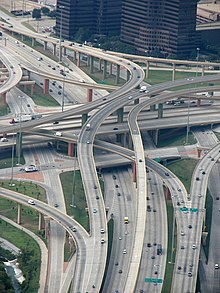
A road is an identifiable route, way, or path between two or more places.[5] Roads are typically smoothed, paved, or otherwise prepared to allow easy travel;[6] though they need not exist, and historically many roads were merely recognizable routes without any formal structure or maintenance.[7] In urban areas, roads may laissez passer through a city or village and be named as streets, serving a dual function as urban space easement and road.[8]
The nigh common road vehicle is the automobile; a wheeled passenger vehicle that carries its own motor. Other users of roads include buses, trucks, motorcycles, bicycles, and pedestrians. As of 2010, there were 1.015 billion automobiles worldwide. Road transport offers complete freedom to road users to transfer the vehicle from i lane to the other and from i route to another according to the need and convenience. This flexibility of changes in location, management, speed, and timings of travel is not bachelor to other modes of send. Information technology is possible to provide door-to-door service simply by route transport.
Automobiles provide loftier flexibility with low capacity, only require loftier energy and area use, and are the chief source of harmful dissonance and air pollution in cities;[9] buses allow for more efficient travel at the cost of reduced flexibility.[10] Route ship by truck is often the initial and terminal stage of freight transport.
Water [edit]
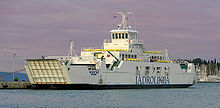
Water transport is movement by ways of a watercraft—such every bit a barge, boat, transport, or sailboat—over a body of water, such as a sea, ocean, lake, canal, or river. The need for buoyancy is common to watercraft, making the hull a dominant aspect of its construction, maintenance, and appearance.
In the 19th century, the first steam ships were developed, using a steam engine to drive a paddle wheel or propeller to move the send. The steam was produced in a boiler using woods or coal and fed through a steam external combustion engine. Now most ships have an internal combustion engine using a slightly refined type of petroleum called bunker fuel. Some ships, such as submarines, use nuclear ability to produce the steam. Recreational or educational arts and crafts still use current of air power, while some smaller craft use internal combustion engines to drive 1 or more propellers or, in the case of jet boats, an inboard water jet. In shallow draft areas, hovercraft are propelled by large pusher-prop fans. (See Marine propulsion.)
Although it is slow compared to other transport, mod sea transport is a highly efficient method of transporting large quantities of goods. Commercial vessels, nearly 35,000 in number, carried 7.4 billion tons of cargo in 2007.[11] Transport by water is significantly less plush than air transport for transcontinental shipping;[12] brusk ocean shipping and ferries remain feasible in coastal areas.[13] [14]
Other modes [edit]
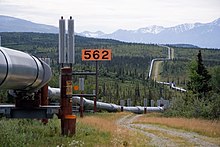
Pipeline transport sends appurtenances through a pipe; well-nigh unremarkably liquid and gases are sent, but pneumatic tubes tin can also send solid capsules using compressed air. For liquids/gases, whatever chemically stable liquid or gas can exist sent through a pipeline. Short-distance systems exist for sewage, slurry, water, and beer, while long-distance networks are used for petroleum and natural gas.
Cable transport is a broad style where vehicles are pulled by cables instead of an internal power source. It is most commonly used at steep gradient. Typical solutions include aerial tramways, elevators, and ski lifts; some of these are too categorized as conveyor transport.
Spaceflight is transport out of Earth's atmosphere into outer infinite by means of a spacecraft. While big amounts of enquiry have gone into technology, information technology is rarely used except to put satellites into orbit and conduct scientific experiments. Notwithstanding, man has landed on the moon, and probes have been sent to all the planets of the Solar Organization.
Suborbital spaceflight is the fastest of the existing and planned transport systems from a place on World to a afar "other place" on Earth. Faster ship could be achieved through office of a low Earth orbit or past following that trajectory even faster, using the propulsion of the rocket to steer it.
Elements [edit]
Infrastructure [edit]
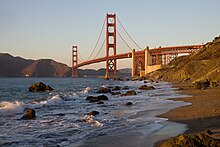

Tunnels, such every bit the Tampere Tunnel, allow traffic to pass hole-and-corner or through rock formations.
Infrastructure is the fixed installations that let a vehicle to operate. It consists of a roadway, a last, and facilities for parking and maintenance. For rail, pipeline, route, and cable transport, the entire way the vehicle travels must exist constructed. Air and watercraft are able to avoid this, since the airway and seaway do not need to exist constructed. Withal, they require fixed infrastructure at terminals.
Terminals such as airports, ports, and stations, are locations where passengers and freight can be transferred from one vehicle or manner to another. For rider send, terminals are integrating unlike modes to allow riders, who are interchanging between modes, to take advantage of each mode's benefits. For example, airport rail links connect airports to the city centres and suburbs. The terminals for automobiles are parking lots, while buses and coaches can operate from unproblematic stops.[15] For freight, terminals act as transshipment points, though some cargo is transported directly from the bespeak of production to the indicate of use.
The financing of infrastructure can either be public or private. Send is often a natural monopoly and a necessity for the public; roads, and in some countries railways and airports, are funded through taxation. New infrastructure projects tin have high costs and are often financed through debt. Many infrastructure owners, therefore, impose usage fees, such every bit landing fees at airports or cost plazas on roads. Independent of this, authorities may impose taxes on the purchase or use of vehicles. Considering of poor forecasting and overestimation of passenger numbers by planners, there is frequently a benefits shortfall for transport infrastructure projects.[16]
Means of transport [edit]
Animals [edit]
Animals used in transportation include pack animals and riding animals.
Vehicles [edit]

A vehicle is a non-living device that is used to movement people and appurtenances. Unlike the infrastructure, the vehicle moves forth with the cargo and riders. Unless being pulled/pushed by a cablevision or muscle-ability, the vehicle must provide its own propulsion; this is most commonly washed through a steam engine, combustion engine, electrical motor, jet engine, or rocket, though other means of propulsion also exist. Vehicles too need a system of converting the energy into movement; this is most commonly done through wheels, propellers, and force per unit area.
Vehicles are well-nigh usually staffed by a driver. However, some systems, such as people movers and some rapid transits, are fully automatic. For passenger transport, the vehicle must take a compartment, seat, or platform for the passengers. Simple vehicles, such as automobiles, bicycles, or simple aircraft, may accept one of the passengers equally a driver.
Operation [edit]

Private transport is simply subject to the owner of the vehicle, who operates the vehicle themselves. For public send and freight transport, operations are done through private enterprise or past governments. The infrastructure and vehicles may exist owned and operated by the same company, or they may be operated by different entities. Traditionally, many countries accept had a national airline and national railway. Since the 1980s, many of these have been privatized. International shipping remains a highly competitive industry with little regulation,[17] but ports can be public-owned.[18]
Policy [edit]
| | This section is missing information almost well-nigh of what constitutes official traffic management and planning, how it integrates with other fields of politics and how it is enforced. (Dec 2021) |
Every bit the population of the globe increases, cities abound in size and population—according to the United Nations, 55% of the world's population alive in cities, and past 2050 this number is expected to rise to 68%.[19] Public ship policy must evolve to run into the changing priorities of the urban globe.[20] The institution of policy enforces gild in transport, which is by nature chaotic as people attempt to travel from one identify to another as fast equally possible. This policy helps to reduce accidents and salvage lives.
Functions [edit]
Relocation of travelers and cargo are the most common uses of transport. Still, other uses be, such as the strategic and tactical relocation of armed forces during warfare, or the civilian mobility construction or emergency equipment.
Passenger [edit]
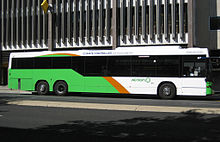
Passenger send, or travel, is divided into public and private transport. Public transport is scheduled services on fixed routes, while private is vehicles that provide ad hoc services at the riders desire. The latter offers better flexibility, simply has lower capacity and a higher environmental impact. Travel may be equally part of daily commuting or for business, leisure, or migration.
Short-haul transport is dominated by the automobile and mass transit. The latter consists of buses in rural and small-scale cities, supplemented with commuter rail, trams, and rapid transit in larger cities. Long-haul transport involves the employ of the machine, trains, coaches, and shipping, the last of which have become predominantly used for the longest, including intercontinental, travel. Intermodal rider transport is where a journey is performed through the use of several modes of transport; since all man transport normally starts and ends with walking, all passenger transport tin be considered intermodal. Public transport may also involve the intermediate change of vehicle, within or across modes, at a transport hub, such equally a motorbus or railway station.
Taxis and buses can be establish on both ends of the public transport spectrum. Buses are the cheapest mode of ship just are not necessarily flexible, and taxis are very flexible just more than expensive. In the middle is demand-responsive transport, offer flexibility whilst remaining affordable.
International travel may exist restricted for some individuals due to legislation and visa requirements.
Medical [edit]

An ambulance from World State of war I
An ambulance is a vehicle used to transport people from or between places of treatment,[21] and in some instances will also provide out-of-hospital medical intendance to the patient. The word is often associated with road-going "emergency ambulances", which grade part of emergency medical services, administering emergency intendance to those with acute medical problems.
Air medical services is a comprehensive term covering the use of air transport to move patients to and from healthcare facilities and accident scenes. Personnel provide comprehensive prehospital and emergency and critical intendance to all types of patients during aeromedical evacuation or rescue operations, aboard helicopters, propeller aircraft, or jet aircraft.[22] [23]
Freight [edit]
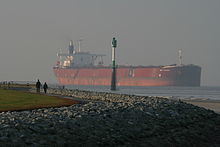
Freight transport, or shipping, is a cardinal in the value chain in manufacturing.[24] With increased specialization and globalization, product is being located further away from consumption, rapidly increasing the demand for ship.[25] Transport creates place utility past moving the goods from the place of production to the place of consumption.[26] While all modes of transport are used for cargo ship, there is high differentiation between the nature of the cargo transport, in which mode is chosen.[27] Logistics refers to the entire process of transferring products from producer to consumer, including storage, send, transshipment, warehousing, fabric-handling, and packaging, with associated commutation of information.[28] Incoterm deals with the handling of payment and responsibility of risk during transport.[29]

Containerization, with the standardization of ISO containers on all vehicles and at all ports, has revolutionized international and domestic merchandise, offering a huge reduction in transshipment costs. Traditionally, all cargo had to be manually loaded and unloaded into the haul of any ship or car; containerization allows for automated handling and transfer between modes, and the standardized sizes allow for gains in economic system of scale in vehicle operation. This has been one of the key driving factors in international trade and globalization since the 1950s.[30]
Bulk transport is mutual with cargo that tin be handled roughly without deterioration; typical examples are ore, coal, cereals, and petroleum. Because of the uniformity of the product, mechanical handling can allow enormous quantities to be handled rapidly and efficiently. The low value of the cargo combined with high volume also means that economies of scale become essential in send, and gigantic ships and whole trains are commonly used to transport majority. Liquid products with sufficient volume may as well exist transported by pipeline.
Air freight has get more than common for products of high value; while less than one percent of world transport by volume is by airline, it amounts to xl per centum of the value. Time has go especially of import in regards to principles such equally postponement and but-in-time within the value chain, resulting in a high willingness to pay for quick commitment of central components or items of high value-to-weight ratio.[31] In improver to mail service, common items sent by air include electronics and fashion clothing.
Bear on [edit]
Economical [edit]
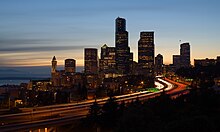
Transport is a key component of growth and globalization, such as in Seattle, Washington, The states.
Transport is a fundamental necessity for specialization—allowing production and consumption of products to occur at different locations. Throughout history, transport has been a spur to expansion; better transport allows more trade and a greater spread of people. Economic growth has always been dependent on increasing the capacity and rationality of transport.[32] But the infrastructure and performance of ship have a great impact on the land, and transport is the largest drainer of energy, making transport sustainability a major issue.
Due to the way modern cities and communities are planned and operated, a concrete stardom between home and work is usually created, forcing people to send themselves to places of piece of work, report, or leisure, equally well as to temporarily relocate for other daily activities. Passenger ship is also the essence of tourism, a major function of recreational transport. Commerce requires the transport of people to bear concern, either to allow contiguous communication for important decisions or to movement specialists from their regular place of work to sites where they are needed.
Planning [edit]
Transport planning allows for high utilization and less touch on regarding new infrastructure. Using models of transport forecasting, planners are able to predict future transport patterns. On the operative level, logistics allows owners of cargo to program send as part of the supply chain. Transport every bit a field is also studied through transport economics, a component for the creation of regulation policy past authorities. Transport applied science, a sub-bailiwick of ceremonious engineering, must accept into account trip generation, trip distribution, mode pick, and road assignment, while the operative level is handled through traffic technology.
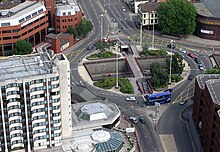
The engineering of this roundabout in Bristol, United Kingdom, attempts to brand traffic flow free-moving.
Considering of the negative impacts incurred, transport ofttimes becomes the discipline of controversy related to choice of mode, besides as increased capacity. Automotive transport tin can exist seen as a tragedy of the commons, where the flexibility and comfort for the individual deteriorate the natural and urban environs for all. Density of development depends on mode of transport, with public transport allowing for ameliorate spatial utilization. Skillful land utilise keeps common activities close to people's homes and places higher-density development closer to ship lines and hubs, to minimize the need for transport. In that location are economies of agglomeration. Beyond transport, some land uses are more efficient when clustered. Ship facilities consume land, and in cities pavement (devoted to streets and parking) tin can easily exceed twenty pct of the total land use. An efficient transport arrangement can reduce land waste.
Likewise much infrastructure and too much smoothing for maximum vehicle throughput mean that in many cities there is too much traffic and many—if not all—of the negative impacts that come with it. It is merely in recent years that traditional practices have started to exist questioned in many places; as a issue of new types of analysis which bring in a much broader range of skills than those traditionally relied on—spanning such areas as ecology impact analysis, public health, sociology, and economic science—the viability of the old mobility solutions is increasingly beingness questioned.
Environment [edit]
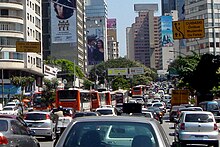
Transport is a major use of free energy and burns about of the world's petroleum. This creates air pollution, including nitrous oxides and particulates, and is a significant correspondent to global warming through emission of carbon dioxide,[34] for which transport is the fastest-growing emission sector.[35] By sub-sector, road send is the largest contributor to global warming.[36] Environmental regulations in developed countries accept reduced private vehicles' emissions; however, this has been offset by increases in the numbers of vehicles and in the use of each vehicle.[34] Some pathways to reduce the carbon emissions of road vehicles considerably have been studied.[37] [38] Energy use and emissions vary largely between modes, causing environmentalists to phone call for a transition from air and route to track and man-powered transport, every bit well as increased transport electrification and energy efficiency.
Other environmental impacts of transport systems include traffic congestion and automobile-oriented urban sprawl, which tin can swallow natural habitat and agricultural lands. By reducing transport emissions globally, it is predicted that there will be significant positive effects on Earth's air quality, acrid rain, smog, and climatic change.[39]
While electric cars are being congenital to cutting downward CO2 emission at the point of use, an approach that is becoming popular among cities worldwide is to prioritize public transport, bicycles, and pedestrian movement. Redirecting vehicle movement to create 20-minute neighbourhoods[forty] that promotes practise while greatly reducing vehicle dependency and pollution. Some policies are levying a congestion accuse[41] to cars for travelling within congested areas during peak time.
Sustainable evolution [edit]
The United Nation's showtime formally recognized the role of send in sustainable evolution in the 1992 United Nation'south Earth summit. In the 2012 United Nation's World Briefing, global leaders unanimously recognized that transport and mobility are primal to achieving the sustainability targets. In recent years, data has been collected to show that the transport sector contributes to a quarter of the global greenhouse gas emissions, and therefore sustainable transport has been mainstreamed across several of the 2030 Sustainable Evolution Goals, especially those related to nutrient, security, health, energy, economic growth, infrastructure, and cities and human settlements. Meeting sustainable transport targets is said to be particularly important to achieving the Paris Agreement.[42]
In that location are diverse Sustainable Development Goals (SDGs) that are promoting sustainable send in order to run into the divers goals. These include SDG three on health (increased road safety), SDG seven on free energy, SDG eight on decent work and economic growth, SDG ix on resilient infrastructure, SDG 11 on sustainable cities (access to transport and expanded public transport), SDG 12 on sustainable consumption and product (ending fossil fuel subsidies), and SDG fourteen on oceans, seas, and marine resources.[43]
History [edit]

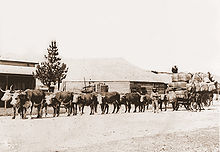
Natural [edit]
Humans' commencement ways to motion included walking, running, and swimming. The domestication of animals introduced a new way to lay the burden of transport on more powerful creatures, allowing the hauling of heavier loads, or humans riding animals for greater speed and elapsing. Inventions such as the wheel and the sled (U.1000. sledge) helped make animal transport more than efficient through the introduction of vehicles.
The first forms of road transport involved animals, such every bit horses (domesticated in the 4th or the 3rd millennium BCE), oxen (from about 8000 BCE),[44] or humans carrying appurtenances over dirt tracks that often followed game trails.
Infrastructure [edit]
Many early civilizations, including those in Mesopotamia and the Indus Valley, constructed paved roads. In classical antiquity, the Persian and Roman empires congenital stone-paved roads to allow armies to travel apace. Deep roadbeds of crushed stone underneath kept such roads dry. The medieval Caliphate afterwards built tar-paved roads.
H2o transport [edit]
Water transport, including rowed and sailed vessels, dates back to time immemorial and was the simply efficient manner to transport large quantities or over large distances prior to the Industrial Revolution. The get-go watercraft were canoes cutting out from tree trunks. Early water transport was accomplished with ships that were either rowed or used the wind for propulsion, or a combination of the 2. The importance of h2o has led to near cities that grew up as sites for trading being located on rivers or on the sea-shore, often at the intersection of two bodies of water.
Mechanical [edit]
Until the Industrial Revolution, transport remained boring and costly, and production and consumption gravitated every bit close to each other as feasible. The Industrial Revolution in the 19th century saw several inventions fundamentally change transport. With telegraphy, communication became instant and independent of the send of concrete objects. The invention of the steam engine, closely followed by its application in rails transport, made state transport independent of homo or animate being muscles. Both speed and capacity increased, assuasive specialization through manufacturing being located independently of natural resources. The 19th century too saw the development of the steam ship, which sped upwards global transport.
With the development of the combustion engine and the machine around 1900, road transport became more than competitive again, and mechanical individual send originated. The first "modernistic" highways were constructed during the 19th century[ citation needed ] with macadam. Later on, tarmac and concrete became the dominant paving materials.
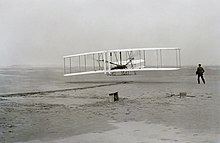
In 1903 the Wright brothers demonstrated the kickoff successful controllable aeroplane, and afterwards World War I (1914–1918) aircraft became a fast way to transport people and express goods over long distances.[45]
After Earth State of war 2 (1939–1945) the motorcar and airlines took higher shares of transport, reducing rail and water to freight and brusk-haul passenger services.[46] Scientific spaceflight began in the 1950s, with rapid growth until the 1970s, when interest dwindled. In the 1950s the introduction of containerization gave massive efficiency gains in freight ship, fostering globalization.[30] International air travel became much more accessible in the 1960s with the commercialization of the jet engine. Forth with the growth in automobiles and motorways, rail and h2o transport declined in relative importance. Afterward the introduction of the Shinkansen in Japan in 1964, high-speed rails in Asia and Europe started attracting passengers on long-booty routes away from the airlines.[46]
Early in U.S. history,[ when? ] private joint-stock corporations endemic almost aqueducts, bridges, canals, railroads, roads, and tunnels. Most such transport infrastructure came under government control in the late 19th and early 20th centuries, culminating in the nationalization of inter-city rider rail-service with the establishment of Amtrak. Recently,[ when? ] however, a movement to privatize roads and other infrastructure has gained some[ quantify ] ground and adherents.[47]
See also [edit]
- Environmental impact of aviation
- Energy efficiency in transport
- Green transport hierarchy
- IEEE Intelligent Transportation Systems Society
- List of emerging transportation technologies
- Journal of Send and Land Use
- Outline of send
- Public transport
- Rail transport by land
- Speed record
- Taxicabs by land
- Transportation engineering
References [edit]
- ^ Crawford, Amy (2021-10-25). "Could flight electric 'air taxis' help set up urban transportation?". The Guardian . Retrieved 2021-xi-nineteen .
- ^ Cooper et al., 1998: 281
- ^ Swine influenza prompts EU warning on travel to U.s.. The Guardian. April 28, 2009.
- ^ Cooper et al., 1998: 279
- ^ "Major Roads of the United States". United States Section of the Interior. 2006-03-thirteen. Archived from the original on 13 Apr 2007. Retrieved 24 March 2007.
- ^ "Road Infrastructure Strategic Framework for Southward Africa". National Section of Ship (Due south Africa). Archived from the original on 27 September 2007. Retrieved 24 March 2007.
- ^ Lay, 1992: 6–seven
- ^ "What is the difference between a road and a street?". Give-and-take FAQ. Lexico Publishing Group. 2007. Retrieved 24 March 2007.
- ^ Harvey, Fiona (2020-03-05). "One in five Europeans exposed to harmful noise pollution – study". The Guardian. ISSN 0261-3077. Retrieved 2020-03-05 .
- ^ Cooper et al., 1998: 278
- ^ The Un Conference on Trade and Development (UNCTAD) 2007, p. x and p. 32.
- ^ Stopford, 1997: 4–six
- ^ Stopford, 1997: 8–9
- ^ Cooper et al., 1998: 280
- ^ Cooper et al., 1998: 275–76
- ^ Bent Flyvbjerg, Mette K. Skamris Holm, and Søren L. Buhl, "How (In)Accurate Are Need Forecasts in Public Works Projects", Journal of the American Planning Association 71:ii, pp. 131–46.
- ^ Stopford, 1997: 422
- ^ Stopford, 1997: 29
- ^ Meredith, Sam (2018-05-17). "Ii-thirds of global population will live in cities past 2050, UN says". CNBC . Retrieved 2018-eleven-xx .
- ^ Jones, Peter (July 2014). "The development of urban mobility: The interplay of academic and policy perspectives". IATSS Research. 38: 7–xiii. doi:ten.1016/j.iatssr.2014.06.001.
- ^ Skinner, Henry Alan. 1949, "The Origin of Medical Terms". Baltimore: Williams & Wilkins
- ^ Branas CC, MacKenzie EJ, Williams JC, Schwab CW, Teter HM, Flanigan MC, et al. (2005). "Access to trauma centers in the United States". JAMA. 293 (21): 2626–33. doi:x.1001/jama.293.21.2626. PMID 15928284.
- ^ Burney RE, Hubert D, Passini L, Maio R (1995). "Variation in air medical outcomes by crew composition: a two-year follow-up". Ann Emerg Med. 25 (ii): 187–92. doi:ten.1016/s0196-0644(95)70322-5. PMID 7832345.
- ^ Chopra and Meindl, 2007: 3
- ^ Chopra and Meindl, 2007: 63–64
- ^ McLeod, Sam; Curtis, Carey (2020-03-xiv). "Agreement and Planning for Freight Movement in Cities: Practices and Challenges". Planning Practise & Research. 35 (2): 201–219. doi:10.1080/02697459.2020.1732660. ISSN 0269-7459. S2CID 214463529.
- ^ Chopra and Meindl, 2007: 54
- ^ Bardi, Coyle and Novack, 2006: iv
- ^ Bardi, Coyle and Novack, 2006: 473
- ^ a b Bardi, Coyle and Novack, 2006: 211–14
- ^ Chopra and Meindl, 2007: 328
- ^ Stopford, 1997: 2
- ^ International Council on Clean Transportation, A earth of thoughts on Phase ii, 16 September 2016 (page visited on 18 Nov 2018).
- ^ a b Fuglestvet; et al. (2007). "Climate forcing from the ship sectors" (PDF). Proceedings of the National University of Sciences. Center for International Climate and Environmental Research. 105 (2): 454–458. Bibcode:2008PNAS..105..454F. doi:10.1073/pnas.0702958104. PMC2206557. PMID 18180450.
- ^ Worldwatch Institute (xvi January 2008). "Analysis: Nano Hypocrisy?". Archived from the original on thirteen Oct 2013. Retrieved 17 January 2008.
- ^ Jan Fuglestvedt; et al. (Jan 15, 2008). "Climate forcing from the transport sectors" (PDF). PNAS. 105 (two): 454–458. Bibcode:2008PNAS..105..454F. doi:10.1073/pnas.0702958104. PMC2206557. PMID 18180450.
- ^ "Claverton-Energy.com". Claverton-Energy.com. 2009-02-17. Retrieved 2010-05-23 .
- ^ Data on the barriers and motivators to more than sustainable transport behaviour is available in the UK Section for Transport study "Climate Change and Transport Choices Archived 2011-05-30 at the Wayback Auto" published in Dec 2010.
- ^ Environment Canada. "Transportation". Archived from the original on July 13, 2007. Retrieved 30 July 2008.
- ^ Planning (2020-09-09). "twenty-minute neighbourhoods". Planning . Retrieved 2020-09-26 .
- ^ "Congestion Accuse (Official)". Transport for London . Retrieved 2020-09-26 .
- ^ "Sustainable ship .:. Sustainable Evolution Noesis Platform". sustainabledevelopment.un.org . Retrieved 2020-09-26 .
- ^ "Sustainable transport at the heart of the Sustainable Development Goals (SDGs) .:. Sustainable Development Knowledge Platform". sustainabledevelopment.un.org . Retrieved 2020-09-26 .
- ^ Watts, Martin (1999). Working Oxen. Shire Anthology. Vol. 342. Princes Risborough, Buckinghamshire: Osprey Publishing. p. 4. ISBN9780747804154 . Retrieved 2016-02-08 .
[...] tamed aurochs became the start domestic oxen. The primeval prove for domestication is found in the Eye E around 10 thousand years agone.
- ^ Bardi, Coyle and Novack, 2006: 158
- ^ a b Cooper et al., 1998: 277
- ^ Clifford Winston, Last Go out: Privatization and Deregulation of the U.S. Transportation System (Washington, D.C.: Brookings Institution, 2010).
Bibliography [edit]
- Bardi, Edward; John Coyle & Robert Novack (2006). Management of Transportation. Thomson S-Western. ISBN0-324-31443-4.
- Chopra, Sunil & Peter Meindl (2007). Supply Chain Management. Pearson. ISBN978-0-13-208608-0.
- Christopher P. Cooper; Rebecca Shepherd (1998). Tourism: Principles and Practice. Financial Times Prent.Int. ISBN978-0-582-31273-ix . Retrieved 22 December 2012.
- Lay, Maxwell K (1992). Ways of the Earth: A History of the World's Roads and of the Vehicles that Used Them . Rutgers Academy Press. ISBN0-8135-2691-iv.
- Stopford, Martin (1997). Maritime Economic science. London: Routledge. ISBN0-415-15310-7.
External links [edit]
| | Wikimedia Commons has media related to Transport. |
| | Wikiquote has quotations related to Send . |
- Transportation from UCB Libraries GovPubs
- Transportation at Curlie
- America On the Move An online transportation exhibition from the National Museum of American History, Smithsonian Establishment
- World Transportation Organization The globe transportation organization (The Non-Profit Advisory Organization)
Source: https://en.wikipedia.org/wiki/Transport
Posted by: harrispresucest.blogspot.com

0 Response to "What Is A Major Factor In The Development Of Health Problems In Transporting Animals?"
Post a Comment